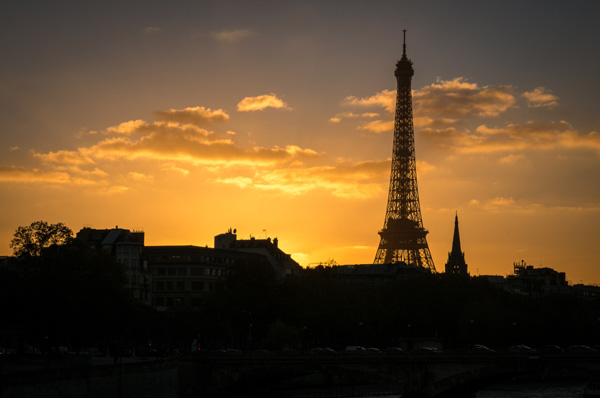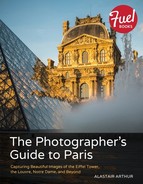The City of Paris
If photography is drawing with light, then what better place in which to practice the art than in the City of Light. It’s not a big city if you consider the main area to be within the Boulevard Périphérique (ring road), although the total metropolitan area is one of the largest in Europe. And, of course, Paris is full of stunning architecture, art, and people.

Fujifilm X-E1, 55mm, ISO 400, 1/680s, f/14
Visitor Information
Paris is a beautiful city, and it’s not just the monuments and museums. It’s the iron railings. The ornate doors. It’s the parks and the shops and the lights. The bridges and the buildings. It’s also, very often, the people. Beauty and elegance are respected, upheld, sought after, and cherished. It’s one of the global centers—if not the global center—for fashion and art.
Paris is also rich in tradition. It’s an old city, dating back more than 2000 years. Notre Dame, for example, celebrated its 850th anniversary in 2013. You’ll find an abundance of patisseries, cafes and markets, featuring fresh fruits and vegetables, fish, cheeses, and wines. It’s not cheap, and it’s not the cleanest city on the planet, but it is rich and vibrant and beautiful. And Paris has so many stories to tell. That’s where you and your camera come in.
Weather
Typically, Paris has mild winters and warm summers like most of Western Europe. Summer temperatures usually vary between 15°–25°C (59°–77°F). They can reach 30°C (86°F) but rarely go much higher.
Rain is common throughout the year, but snow is rare. If you’re fortunate and it does snow while you’re here, make the most of it quickly because it will tend to be light and melt within a few days.
Getting Around
The Metro and RER networks are a quick and easy solution. A pack of ten tickets, available from the machines and ticket counters at all stations, should last for a few days. I recommend walking as much a possible, though. The main sights are not that far apart, and you’re always likely to stumble across more images that you’ll want to capture on the way.
If you have a smartphone or tablet, it’s worth downloading a map of central Paris from Google Maps. Storing the map offline means you don’t have to rely on mobile reception or resort to data roaming. To download, first search for “Paris” and zoom so that the area you want to download is displayed onscreen. Then type “OK maps” into the search bar to start the download. If you get stuck, you can also find maps at the entrance to most Metro stations.
Local Inspiration
As a photographer in Paris, you are following in many great and accomplished footsteps. To name a few:
• Eugène Atget (1857–1927). Atget pioneered documentary photography. His aim was to capture scenes of Paris before they changed under modernization, whether as commissioned works or as his own projects. His work was largely unrecognized during his lifetime.
• Man Ray (1890–1976). Born in America, Ray spent most of his career in Paris. He considered himself primarily a painter, but he was best known for his avant-garde fashion and portrait photography.
• Brassaï (1899–1984). Hungarian by birth, Brassaï’s fame came through his photography of Paris, including the upper classes and his artist friends such as Dalí and Picasso.
• Henri Cartier-Bresson (1908–2004). Generally considered to be the pioneer of photojournalism, his “Decisive Moment” photography and its implications have inspired generations of photographers.
• Robert Doisneau (1912–1994). Another pioneer of photojournalism, Doisneau is famous for his 1950 photograph “Le baiser de l’hôtel de ville” (“The Kiss by the Town Hall”).
• Willy Ronis (1910–2009). Inspired by Alfred Stieglitz and Ansel Adams, Ronis worked in the same studio as Brassaï and Doisneau. He was the first French photographer to work for Life magazine, and his best-known works are post-war images of Paris and Provence.
If you have time, check out the many galleries. Find out what exhibits are on display during your visit. Following are a few suggestions for galleries that specialize in photography:
• Musée Carnavalet http://www.carnavalet.paris.fr/
• Albert Kahn Musée & Jardins http://albert-kahn.hauts-de-seine.net/
• Fondation Henri Cartier-Bresson http://www.henricartierbresson.org/
• Maison Européenne de la Photographie (MEP) http://www.mep-fr.org/
• Galerie Agathe Gaillard http://www.agathegaillard.com/
• Baudoin-Lebon http://www.baudoin-lebon.com/
Safety
OK, so I think it’s worth a quick word of warning. Just as in any other major city, some people will seek to deprive you of the contents of your wallet, by fair means or foul. Current favorite scams include:
• A guy near you happens to “find” a ring on the ground and offers it to you. It’s probably “very valuable,” so a little compensation for his trouble? Walk away.
• Someone offers a colorful fabric bracelet for your wrist. It’s not a gift. Ignore them. This is particularly common on the steps leading up to the Sacre Cœur.
• The classic ball/stone/coin under three cups. Someone has just guessed correctly and won some money playing it, just as you were passing by! It’s not just the guy performing that’s in on the trick, or the new “winner.” Others will be with them, and they have probably already noticed that nice camera you’re carrying.
Not that central Paris is a particularly dangerous place to visit—far from it. Just don’t make it easy for someone to spoil your visit.
